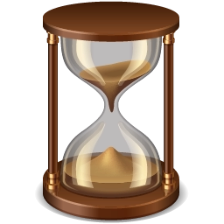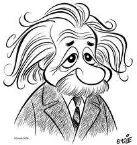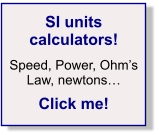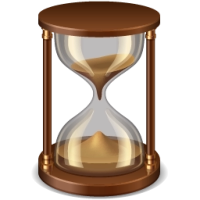
Time












Time is what stops everything from happening all at once
Return now to the SI Units Home Page to learn more about the full set of SI units and properties,
most with worked examples.

Of the seven quantities measured by the SI base units time is by far the most mysterious. The
SI unit of time, the second, symbol s, is easy enough to define, but time itself can only be
defined in reference to other quantities. As we will see, time isn't even the steady thing that it
seems to be, but can change how quickly or slowly is passes depending on speed and mass.

The traditional measurement of time is based on the length of a day. We split the day into
hours, minutes and seconds. This is eminently sensible and something so obvious that we
don't give it much thought. How, though, would we describe a second to an alien? It's no good
saying that it's 1/60th of a minute, or 1/86400th of a day. The alien won't know what a minute
or Earth day is either.
Aliens aside, using the day as a measurement also has its problems. One day is the time taken
for the Earth to complete a rotation on its axis, but, importantly, the time it takes changes very
slightly over long periods. Every so often a second needs to be added to the year to
compensate for the Earth's rotation very gradually slowing down, caused mostly by the Moon's
mass pulling on the Earth. Clearly, if we want the second to be a precise measurement we
need to find something else to base it on.
It wasn't until the invention of atomic clocks, which work by measuring properties of certain
atoms, that a really precise measurement of the passing of time became possible. Using such
clocks the second was defined in 1967 as:
The duration of 9,192,631,770 periods of the radiation
corresponding between the two hyperfine levels of the
ground state of the caesium-133 atom.
In short, this means that the vibrations of a particular type of atom are observed and counted.
The vibrational rates of atoms are incredibly precise and so allow for much more accurate
measurements of time than any other system.
That much, then, is straightforward. Time is measured in seconds and we use the vibrational
rate of a certain kind of atom to define exactly how long a second is. For most purposes that's
good enough and we don't need to say any more about it. However, it's interesting to note that
time can, under certain circumstances, change and so flow at a different rate.
In particular, when an object moves, any object at any speed, its internal clock slows down.
This is sometimes summed up as "moving clocks run slow":

Clocks slow down when moving
If this is true why don't we notice our wristwatch slowing down when on the bus? The answer
is that even though the watch will have slowed down, it's by such a tiny amount that it's not
even nearly noticeable. We need to be moving much, much faster before the effects become
apparent and even then something else very strange needs to be taken into account.
The speed of light is close to 300,000 km a second (186,300 miles a second) and is the
fastest thing there is. Moving as fast as a beam of light we could travel seven and a half times
around the world every second. It's only at speeds comparable to this that the effects of time
dilation, the slowing down of clocks, become apparent. For example, if we move at about 90%
of the speed of light our clocks, including our body clocks, will slow down by about half of their
usual rate. If we could travel at 99.999% of the speed of light our clocks would come to a
virtual standstill.
I mentioned that there was something else that was very strange about the changing of the
rate of time. If we moved at very high speeds our clocks would slow down, but only relative to
external observers, i.e. to people watching from a platform which is stationary relative to the
moving object.
They would see the occupants of such a high speed platform, such as a rocket, moving very
slowly. Likewise, the occupants of the rocket would see the observers as moving very quickly.
Their clocks are measuring time differently to one another based on their relative speeds. This
is the basis of Einstein's famous Theory of Relativity, and you can read more about it,
together with worked examples by clicking here.

Click for seconds in a day, week, month, year conversions.



Advertisement

Time









Time is what stops everything from happening all at once
Return now to the SI Units Home Page to learn more about the
full set of SI units and properties, most with worked examples.

Of the seven quantities measured by the SI base units time is by
far the most mysterious. The SI unit of time, the second, symbol
s, is easy enough to define, but time itself can only be defined in
reference to other quantities. As we will see, time isn't even the
steady thing that it seems to be, but can change how quickly or
slowly is passes depending on speed and mass.

The traditional measurement of time is based on the length of a
day. We split the day into hours, minutes and seconds. This is
eminently sensible and something so obvious that we don't give
it much thought. How, though, would we describe a second to an
alien? It's no good saying that it's 1/60th of a minute, or
1/86400th of a day. The alien won't know what a minute or Earth
day is either.
Aliens aside, using the day as a measurement also has its
problems. One day is the time taken for the Earth to complete a
rotation on its axis, but, importantly, the time it takes changes
very slightly over long periods. Every so often a second needs to
be added to the year to compensate for the Earth's rotation very
gradually slowing down, caused mostly by the Moon's mass
pulling on the Earth. Clearly, if we want the second to be a
precise measurement we need to find something else to base it
on.
It wasn't until the invention of atomic clocks, which work by
measuring properties of certain atoms, that a really precise
measurement of the passing of time became possible. Using
such clocks the second was defined in 1967 as:
The duration of 9,192,631,770 periods of the radiation
corresponding between the two hyperfine levels of the
ground state of the caesium-133 atom.
In short, this means that the vibrations of a particular type of
atom are observed and counted. The vibrational rates of atoms
are incredibly precise and so allow for much more accurate
measurements of time than any other system.
That much, then, is straightforward. Time is measured in
seconds and we use the vibrational rate of a certain kind of atom
to define exactly how long a second is. For most purposes that's
good enough and we don't need to say any more about it.
However, it's interesting to note that time can, under certain
circumstances, change and so flow at a different rate.
In particular, when an object moves, any object at any speed, its
internal clock slows down. This is sometimes summed up as
"moving clocks run slow":

Clocks slow down when moving
If this is true why don't we notice our wristwatch slowing down
when on the bus? The answer is that even though the watch will
have slowed down, it's by such a tiny amount that it's not even
nearly noticeable. We need to be moving much, much faster
before the effects become apparent and even then something
else very strange needs to be taken into account.
The speed of light is close to 300,000 km a second (186,300
miles a second) and is the fastest thing there is. Moving as fast
as a beam of light we could travel seven and a half times around
the world every second. It's only at speeds comparable to this
that the effects of time dilation, the slowing down of clocks,
become apparent. For example, if we move at about 90% of the
speed of light our clocks, including our body clocks, will slow
down by about half of their usual rate. If we could travel at
99.999% of the speed of light our clocks would come to a virtual
standstill.
I mentioned that there was something else that was very strange
about the changing of the rate of time. If we moved at very high
speeds our clocks would slow down, but only relative to external
observers, i.e. to people watching from a platform which is
stationary relative to the moving object.
They would see the occupants of such a high speed platform,
such as a rocket, moving very slowly. Likewise, the occupants of
the rocket would see the observers as moving very quickly. Their
clocks are measuring time differently to one another based on
their relative speeds. This is the basis of Einstein's famous
Theory of Relativity, and you can read more about it, together
with worked examples by clicking here.


Advertisement


